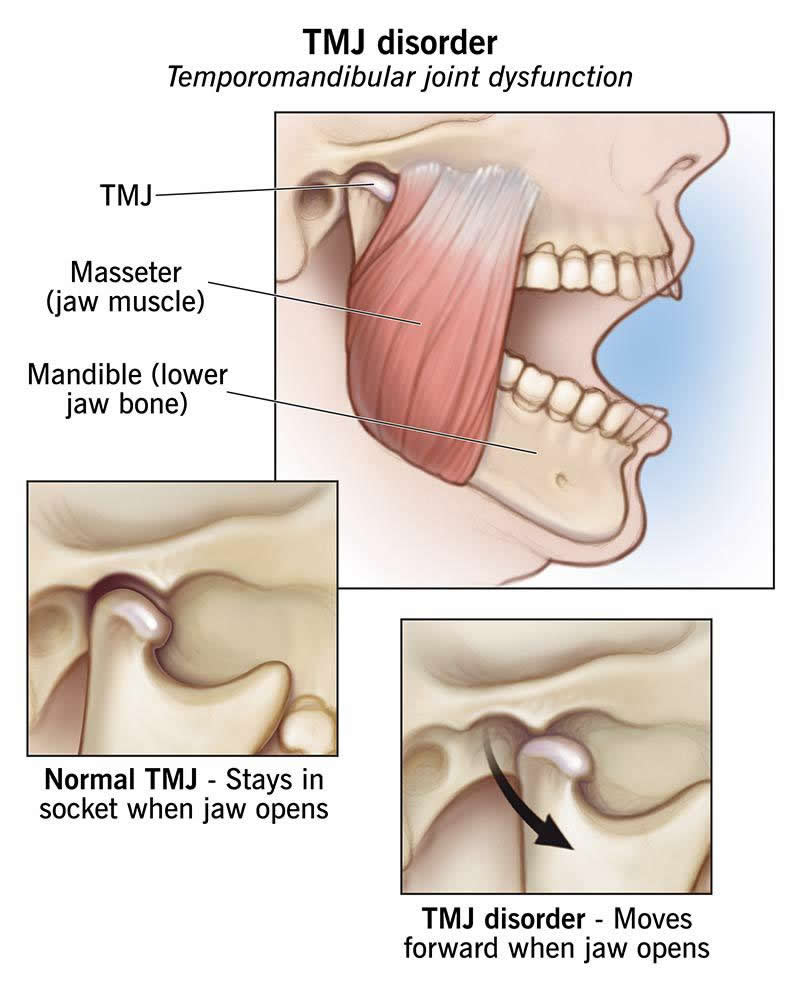Temporomandibular Joint (TMJ) Disorders
Temporomandibular joint disorders (TMDs) affect the joints that help your jaw move. They can cause pain, clicking, headaches and trouble chewing. TMD is common in adults and often starts between the ages of 20 and 40. Early care can make a big difference in how you feel day to day.
What Are TMJ Disorders?

TMJ disorders affect the joints in your jaw and the muscles around them. The medical term is temporomandibular joint dysfunction (TMD), but many people call it TMJ.
You have two TMJs — one on each side of your face, near your ears. These joints help you chew, talk, and move your jaw.
TMD is common. It affects up to 12 million people in the U.S., mostly between the ages of 20 and 40. Females are twice as likely to have it.
The good news? It’s treatable and rarely causes lasting problems.
Symptoms and Causes
Temporomandibular joint dysfunction (TMD) symptoms
Signs of TMD can include:
- Jaw or face pain
- Headaches or migraines
- Jaw stiffness or locking
- Clicking, popping, or grinding sounds
- Trouble opening or closing your mouth
- Earaches or ringing
- Tooth pain
- Neck or shoulder pain
If these symptoms don’t go away, see a healthcare provider.
TMD causes
TMD can happen for many reasons:
- Jaw injury (like a break or dislocation)
- Teeth grinding or clenching (bruxism)
- Arthritis in the jaw
- A misaligned bite
- Stress that causes jaw tension
Risk factors
Some habits can make TMD worse:
- Chewing on pens, ice, or nails
- Poor posture
- Taking large bites of food
- Using teeth as tools
- Daytime clenching or sleeping on your stomach
How to lower your risk
Try these tips:
- Wear a mouth guard if you grind your teeth or play contact sports.
- Sit and stand with good posture.
- Reduce stress with deep breathing or meditation.
Complications of TMJ disorders
TMD can lead to long-term pain, chewing problems, or damage from grinding your teeth. The causes often overlap, so it may take time to find the right treatment.
Diagnosis and Tests
How doctors diagnose this disorder
To diagnose TMD, your provider will do a physical exam and may order imaging tests. They’ll check how your jaw moves and look for signs of pain or stiffness.
Tests that are used
During your exam, your provider may:
- See how wide you can open your mouth
- Press around your jaw to check for tenderness
- Feel your joints as you open and close your mouth
You may also need imaging tests, like:
- Dental X-rays
- CT scans
- MRIs
Finding TMD early can make treatment more effective.
Management and Treatment
How is TMD treated?
Treatment depends on what’s causing your symptoms and how severe they are. Most people start with noninvasive options.
Medications
Medicines can help ease pain, swelling and muscle tension. Your provider may suggest:
- Acetaminophen (Tylenol®) for pain
- NSAIDs (nonsteroidal anti-inflammatory drugs) like ibuprofen (Advil®) or naproxen (Aleve®)
- Muscle relaxers for clenching or grinding
- Antidepressants to help with chronic pain
Nonsurgical options
Many therapies don’t involve surgery. They focus on relaxing your jaw and improving movement:
- Custom mouth guards or splints
- Jaw exercises through physical therapy
- Trigger point injections (like dry needling or steroids)
- Ultrasound therapy to relax muscles
- TENS (gentle electrical currents) to ease tension
- Changing habits, like avoiding hard foods or improving posture
Surgical options
If other treatments don’t help, your provider may suggest surgery, such as:
- Arthrocentesis to flush the joint
- TMJ arthroscopy (a minimally invasive procedure)
- Open-joint surgery for more serious problems
TMD treatment often combines self-care, medical devices and professional care.
When should I see my healthcare provider?
If your jaw pain, clicking or stiffness doesn’t improve, talk to a healthcare provider. They can help find what’s causing it and suggest the right treatment.
Outlook / Prognosis
What can I expect if I have a TMJ disorder?
TMD can be short-term or last longer. Some people feel better in a week or two. Others may need ongoing care. With the right treatment, most people get relief and normal jaw movement.
Can TMJ disorder be cured?
Yes. With early diagnosis and the right treatment, TMD is often manageable — and sometimes curable.
A note from Wockr
TMD affects people in different ways. Whether your pain is short-term or ongoing, help is available. If symptoms are interfering with your daily life, don’t wait — talk to your healthcare provider.